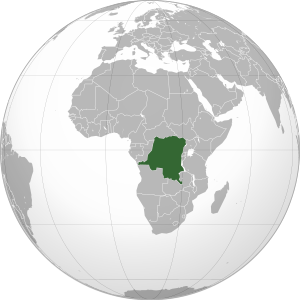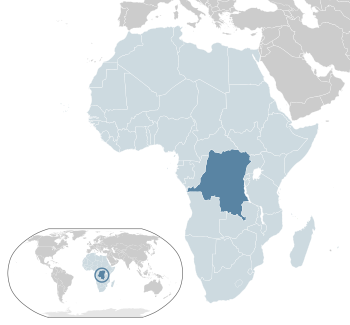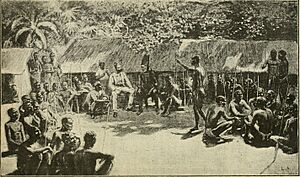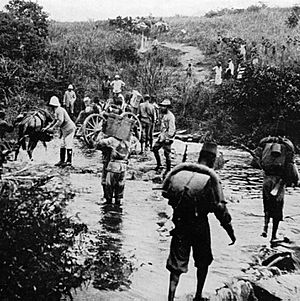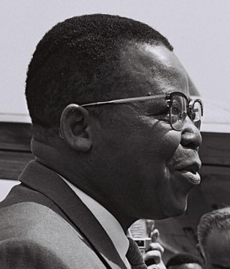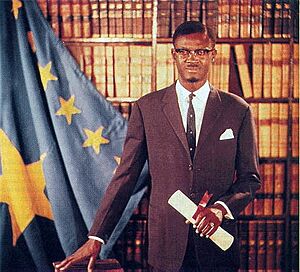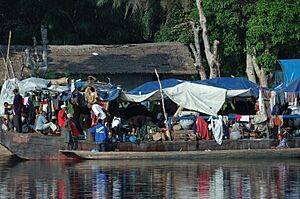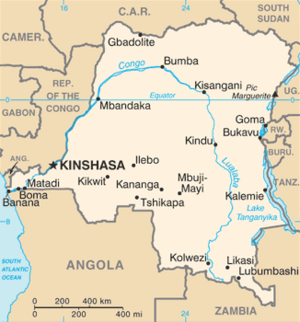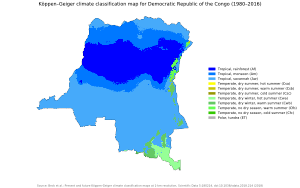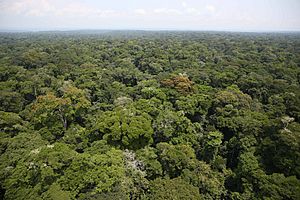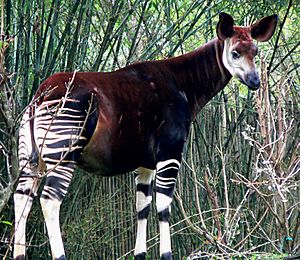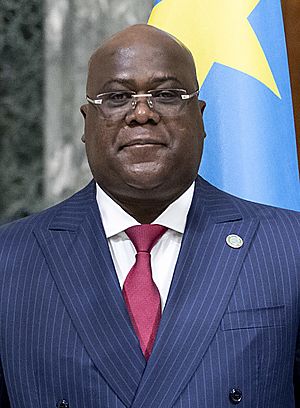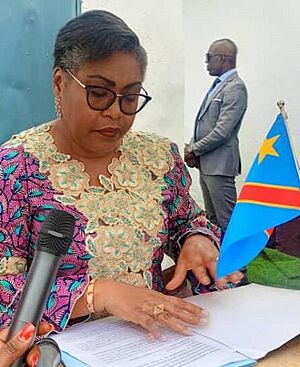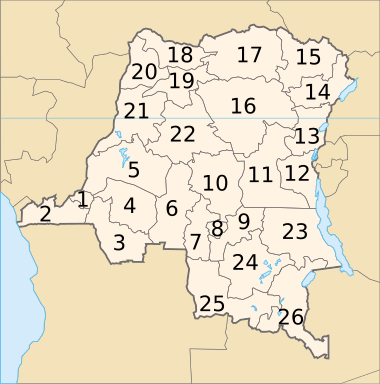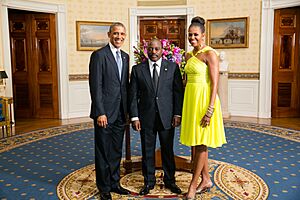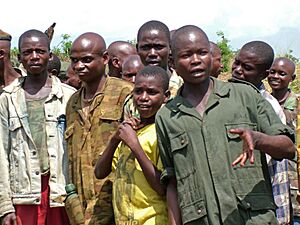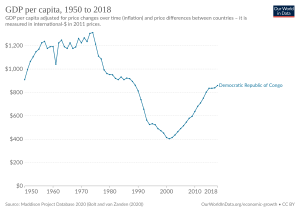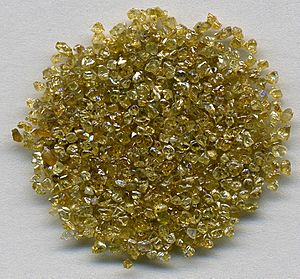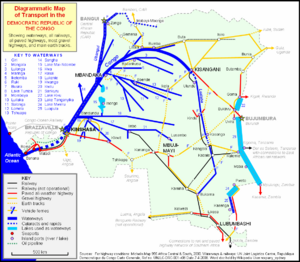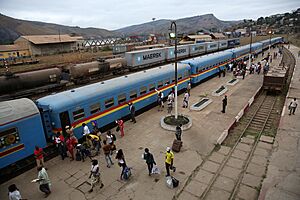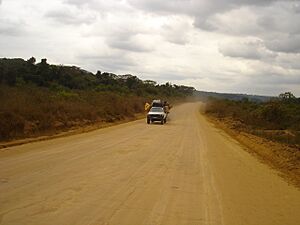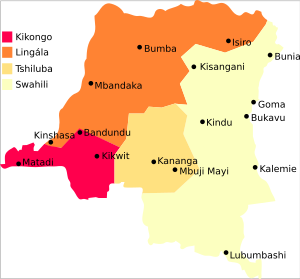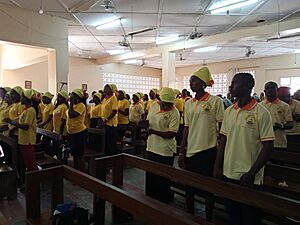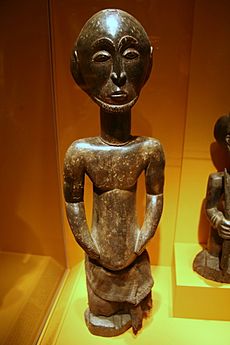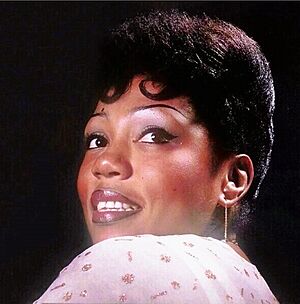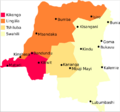Democratic Republic of the Congo facts for kids
Quick facts for kids
Democratic Republic of the Congo
République démocratique du Congo (French)
|
|
|---|---|
|
|
|
|
Motto: "Justice – Paix – Travail"
("Justice – Peace – Work") |
|
|
Anthem: "Debout Congolais"
("Arise, Congolese") |
|
| Capital and largest city
|
Kinshasa 4°19′S 15°19′E / 4.317°S 15.317°E |
| Official languages | French |
| Recognised national languages | |
| Religion
(2021)
|
|
| Demonym(s) | Congolese |
| Government | Unitary semi-presidential republic |
| Felix Tshisekedi | |
| Judith Suminwa | |
| Legislature | Parliament |
| Senate | |
| National Assembly | |
| Formation | |
|
• Colonised by Leopold II of Belgium
|
17 November 1879 |
| 1 July 1885 | |
| 15 November 1908 | |
|
• Independence from Belgium
|
30 June 1960 |
|
• Admitted to the United Nations
|
20 September 1960 |
|
• Democratic Republic
|
1 August 1964 |
| 27 October 1971 | |
|
• First Congo War
|
17 May 1997 |
|
• Current constitution
|
18 February 2006 |
| Area | |
|
• Total
|
2,345,409 km2 (905,567 sq mi) (11th) |
|
• Water (%)
|
3.32 |
| Population | |
|
• 2025 estimate
|
|
|
• Density
|
48/km2 (124.3/sq mi) |
| GDP (PPP) | 2024 estimate |
|
• Total
|
|
|
• Per capita
|
|
| GDP (nominal) | 2024 estimate |
|
• Total
|
|
|
• Per capita
|
|
| Gini (2012) | ▼ 42.1 medium |
| HDI (2023) | low · 171st |
| Currency | Congolese franc (CDF) |
| Time zone | UTC+1 to +2 (WAT and CAT) |
| Date format | dd/mm/yyyy |
| Driving side | right |
| Calling code | +243 |
| ISO 3166 code | CD |
| Internet TLD | .cd |
The Democratic Republic of the Congo (DRC), also known as DR Congo or Congo-Kinshasa, is a large country in Central Africa. It is the second-largest country in Africa by land area. With about 112 million people, it is the most populated country where French is an official language. French is the main language, but over 200 local languages are also spoken. The capital and largest city is Kinshasa.
The DRC is bordered by several countries and the South Atlantic Ocean. Most of the country is covered by dense rainforests and many rivers. The eastern and southeastern parts have mountains. People have lived in this area for about 90,000 years. Around 2,000 to 3,000 years ago, Bantu peoples settled here. Important kingdoms like the Kingdom of Kongo and the Luba and Lunda empires existed before Europeans arrived.
In 1885, King Leopold II of Belgium took control of the Congo territory, calling it the Congo Free State. There were many terrible events during this time. In 1908, it became a Belgian colony. The Congo gained independence from Belgium in 1960. After independence, the country faced many challenges, including conflicts and changes in leadership. Mobutu Sese Seko took power in 1965 and renamed the country Zaire in 1971.
After Mobutu's rule, the country faced more conflicts, including the First Congo War (1996–1997) and the Second Congo War (1998–2003). These wars caused many deaths and much suffering. In 1997, the country's name was changed back to the Democratic Republic of the Congo. In 2019, Félix Tshisekedi became president, marking the first peaceful transfer of power since independence. However, fighting continues in some eastern parts of the country.
Even though the DRC has many natural resources, it is one of the world's poorest countries. This is due to political problems, lack of good roads and services, and a history of exploitation. The largest cities after Kinshasa are Lubumbashi and Mbuji-Mayi, both known for mining. The DRC mainly exports raw minerals and metal. It is a member of the United Nations and the African Union.
Contents
About the Name
The Democratic Republic of the Congo is named after the Congo River. This river is the world's deepest and the third largest by how much water it carries. Early European sailors named the river after the Kingdom of Kongo and its people, the Kongo people. The word Kongo comes from the Kongo language and means "to gather."
Over time, the country has had several names:
- Congo Free State
- Belgian Congo
- Republic of the Congo-Léopoldville
- Democratic Republic of the Congo
- Republic of Zaire
- Democratic Republic of the Congo (its current name)
The name Zaire comes from a Portuguese word nzadi, meaning "river." This name was used for the Congo River in the 16th and 17th centuries. To avoid confusion with its neighbor, the Republic of the Congo, the DRC is sometimes called Congo (Kinshasa) or Congo-Kinshasa.
A Look at History
Early Times
People lived in the area now known as the Democratic Republic of the Congo as far back as 90,000 years ago. Evidence like the Semliki harpoon shows early tools used for fishing. Around 2,000 to 3,000 years ago, Bantu peoples moved into Central Africa. They brought new farming methods and iron tools. This led to the growth of early states and kingdoms.
By the 13th century, there were several groups of states in the western Congo Basin. The Kingdom of Kongo became very powerful in the west. In the east, the Luba Empire and Lunda Empire grew in the 15th and 17th centuries.
The Congo Free State (1877–1908)
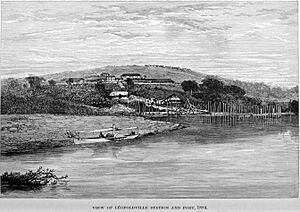
From the 1870s, King Leopold II of Belgium began exploring and taking control of the Congo. He claimed the land as his private property at the Berlin Conference in 1885, calling it the Congo Free State. Leopold's rule focused on getting rubber from the region. To force people to collect rubber, his army, the Force Publique, used very cruel methods. Many Congolese people died from exploitation and disease during this period.
News of these terrible events spread. In 1904, a British official, Roger Casement, investigated and confirmed the abuses. This led to international pressure on Leopold II.
Belgian Congo (1908–1960)
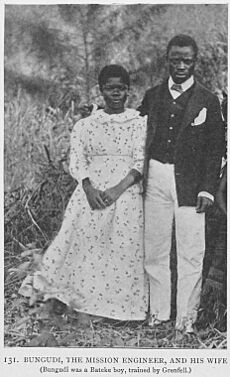
In 1908, the Belgian government took control of the Congo from King Leopold II. It became a Belgian colony. The new government tried to improve healthcare and education, but still controlled the territory strictly. No political activity was allowed for Congolese people.
The Belgian Congo was involved in both World Wars. During World War I, the Force Publique fought against German colonial forces in East Africa. In World War II, the Congo provided important resources for the Belgian government in exile. Congolese forces also fought in Allied campaigns in Africa.
Independence and Challenges (1960–1965)
In May 1960, a nationalist movement led by Patrice Lumumba won elections. Lumumba became the first Prime Minister, and Joseph Kasa-Vubu became President. The Belgian Congo gained independence on June 30, 1960, and was named the Republic of the Congo. To avoid confusion with a neighboring country, it became known as the Democratic Republic of the Congo (DR Congo).
Soon after independence, there were many problems. Parts of the country tried to break away. Lumumba was removed from office and later died in 1961. Belgium later apologized for its role in his death. Mobutu Sese Seko took power in 1965. In 1971, he changed the country's name to Zaire.
Mobutu's Rule and Zaire (1965–1997)
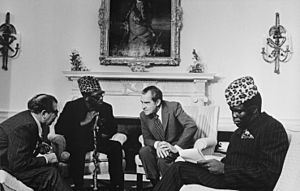
Mobutu's rule was a single-party system. He was the only candidate in elections. While there was some peace, his government was known for not respecting human rights and for widespread corruption. This corruption was so common it was called "Zairian sickness." Mobutu and his friends took a lot of money, and the country's roads and services suffered.
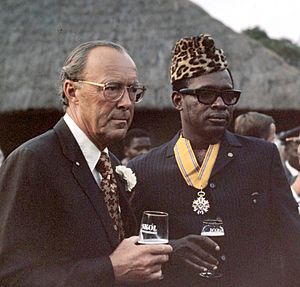
Mobutu also changed the names of cities to reflect African nationalism. Léopoldville became Kinshasa, and the country became the Republic of Zaire. Mobutu remained in power until armed forces made him leave in 1997. He died in exile later that year.
Wars and Peace Efforts (1996–2007)
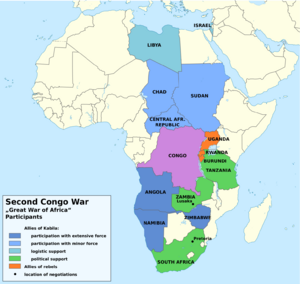
In 1996, a conflict began in eastern Zaire, leading to the First Congo War. This war ended with Mobutu's overthrow. Laurent-Désiré Kabila became president and changed the country's name back to the Democratic Republic of the Congo.
However, a new conflict, the Second Congo War, started in 1998. Many countries and armed groups were involved. This war caused millions of deaths and is considered one of the deadliest conflicts since World War II. Laurent-Désiré Kabila died in 2001, and his son, Joseph Kabila, took over. Peace talks led to an agreement in 2002–2003. The United Nations sent peacekeepers to help. In 2006, the DRC held its first multi-party elections since 1960, and Joseph Kabila was sworn in as president.
Ongoing Challenges (2008–Present)
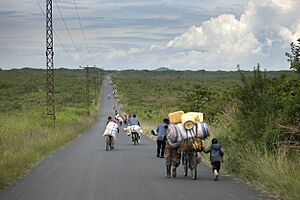
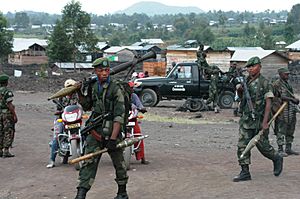
Even after the major wars, conflicts continued, especially in the eastern regions. Groups like the National Congress for the Defence of the People (CNDP) and the March 23 Movement (M23) rebelled against the government. Neighboring countries have sometimes been accused of supporting these groups. The United Nations has a large peacekeeping mission in the DRC.
In 2015, protests broke out because President Kabila stayed in office past his term. Elections were finally held in December 2018. Félix Tshisekedi was announced as the winner and became president in January 2019. This was the first peaceful transfer of power in the DRC since independence.

Since 2022, the M23 Movement has become active again, leading to more fighting in the east. This has caused tension between the DRC and Rwanda. In June 2025, a peace agreement was signed between Rwanda and the DRC, aiming to end the conflict and improve relations.
Geography and Environment
The DRC is in central sub-Saharan Africa. It is the second-largest country in Africa by area. The country is located on the Equator, meaning it has a tropical climate with a lot of rain and thunderstorms. This climate supports the Congo rainforest, which is the second-largest rainforest in the world.
The Congo River system is very important to the country. The river and its many branches are used for transportation and trade. The Congo River is the second-largest river in the world by flow and by the area it drains. Its sources are in the Albertine Rift Mountains in the east.
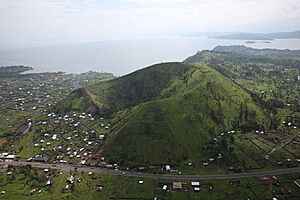
The eastern part of the DRC is mountainous due to the Albertine Rift. This area also has volcanoes, which sometimes erupt. The rift valley has also revealed many valuable minerals in the south and east. The DRC has large amounts of cobalt, copper, diamonds, gold, and other minerals. In 2002, Mount Nyiragongo erupted, causing lava to flow through the city of Goma, forcing many people to leave their homes.
Biodiversity and Conservation

The DRC's rainforests are home to many different plants and animals. These include rare and unique species like the common chimpanzee, the bonobo, the African forest elephant, mountain gorilla, and okapi. Five of the country's national parks are World Heritage Sites, protecting these important animals and their habitats. The DRC is one of the most biodiverse countries in Africa.
However, the country faces environmental challenges. Deforestation (cutting down forests) and poaching (illegal hunting) threaten wildlife. Water pollution and mining also cause problems. The rate of deforestation has increased in recent years.
Government and Politics
The Democratic Republic of the Congo is a semi-presidential republic. The president is the head of state, elected by the people for five years. The prime minister is the head of government, chosen by the president with support from the parliament. The parliament has two parts: the Senate and the National Assembly.
The DRC's political system has faced challenges with corruption and human rights. Organizations like Freedom House and The Economist Democracy Index have described it as authoritarian. This means that power is often held by a few people, and citizens' rights are sometimes limited.
During Joseph Kabila's presidency (2001–2019), there were concerns about corruption and delays in elections. In 2019, Félix Tshisekedi became president after an election. In 2023, he was reelected. In 2024, Judith Suminwa was appointed prime minister, becoming the first woman to hold this position in the DRC.
Administrative Divisions
The country is divided into the city-province of Kinshasa and 25 other provinces. These provinces are further divided into smaller areas called territories and cities.
| 1. Kinshasa | 14. Ituri Province | |
| 2. Kongo Central | 15. Haut-Uele | |
| 3. Kwango | 16. Tshopo | |
| 4. Kwilu Province | 17. Bas-Uele | |
| 5. Mai-Ndombe Province | 18. Nord-Ubangi | |
| 6. Kasaï Province | 19. Mongala | |
| 7. Kasaï-Central | 20. Sud-Ubangi | |
| 8. Kasaï-Oriental | 21. Équateur | |
| 9. Lomami Province | 22. Tshuapa | |
| 10. Sankuru | 23. Tanganyika Province | |
| 11. Maniema | 24. Haut-Lomami | |
| 12. South Kivu | 25. Lualaba Province | |
| 13. North Kivu | 26. Haut-Katanga Province |
Foreign Relations
The DRC is important globally because it has many valuable raw materials. For example, it has 80% of the world's cobalt reserves. Cobalt is used in many industries, including making parts for jet engines and batteries for electric cars. This makes the DRC a key player in the global economy.
China has invested a lot in the DRC, and the DRC exports many goods to China. In 2024, China was its largest trade partner. The DRC is also a member of several African economic groups.
Military and Law Enforcement
The military of the Democratic Republic of the Congo is called the FARDC. It includes the army, air force, and navy. There is also a special Republican Guard that protects the president. The FARDC has many soldiers, but it faces challenges like low training and equipment.
The FARDC was formed in 2003 by combining former rebel groups. It has been fighting against over 100 armed groups in the eastern and central parts of the country for many years. President Tshisekedi started military reforms in 2022 to make the army stronger.
The Congolese National Police is the main police force. The DRC's laws are based on Belgian law. The country has faced issues with corruption, which has affected its economy and public services. In 2020, a high-ranking official was found guilty of corruption, showing efforts to fight this problem.
Human Rights
Human rights in the DRC have been a concern. Child soldiers have been used in conflicts, and many children are still involved with armed groups. There have also been reports of child labor and forced labor.
The DRC has laws against same-sex marriage, and attitudes towards the LGBT community are generally not positive. Violence against women is a serious issue, especially in the eastern part of the country, where it has been used as a weapon in conflicts.
Economy and Resources
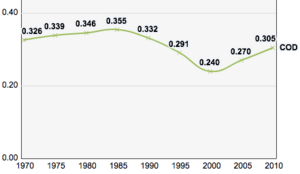
The DRC's economy has grown since the end of the Second Congo War. Its main exports are minerals and metals, especially cobalt and copper. China is its biggest trade partner. The country has received a lot of foreign investment, especially in mining.
Despite its rich resources, the DRC is one of the poorest countries in the world. Many people (65%) work in subsistence agriculture, growing just enough food for themselves. Most jobs are informal, and many young people are unemployed. In 2024, about 73.5% of people lived on less than $2.15 per day.
At independence in 1960, the DRC was one of the most industrialized countries in Africa. It has huge amounts of raw minerals, estimated to be worth over $24 trillion. However, its economy has struggled due to political instability and corruption.
Mining Industry
The mining sector is a major part of the DRC's economy. The country is the world's largest producer of cobalt and a big producer of copper and diamonds. It has a large share of the world's coltan and cobalt reserves. Cobalt is very important for lithium-ion batteries used in electric vehicles.
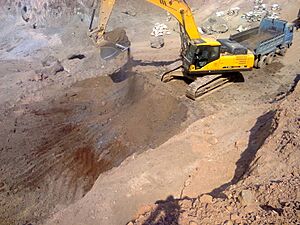
Many people also work in small-scale, informal mining. Some minerals, called conflict minerals, have been smuggled out of the country, helping to fund conflicts. Large mining companies, like Katanga Mining Limited, operate big mines and refineries.
The DRC has made deals with China to exchange mining rights for investments in infrastructure like roads and railways. While these deals bring some development, they have also been criticized for not always benefiting the DRC fairly.
Transportation
The DRC has many roads and railways, but most are in poor condition. It can be hard to travel by road across the country due to dense forests and many rivers. Air and river travel are very important because of these challenges.
The Congo River is like a main highway for transportation. Around two million tons of goods travel through the port of Kinshasa each year. The country's main cities are not well connected by roads or railways. Air travel has increased, but safety has been a concern, leading to bans on DRC airlines in Europe.
Energy
The company Société Nationale d'Électricité (SNEL) controls electricity in the DRC. However, only about 15% of the country has access to electricity. The DRC has a huge potential for hydro-electricity from the Congo River, especially at the Inga dams. This power could light up the entire continent.
The country also has a lot of sunlight, making it good for solar power. Many solar power systems are already in use across the country.
People and Culture
Population and Ethnic Groups
The DRC has a large and growing population, estimated at over 115 million in 2024. It has over 250 different ethnic groups and 450 tribes. Because of this, no single ethnic group is dominant. Some of the largest groups include the Luba-Kasaï, Kongo, and Mongo people.
Languages
French is the official language and helps people from different groups communicate. In 2021, about 74% of the population could speak French.
There are about 242 languages spoken in the country. Four of them are considered national languages: Kituba, Lingala, Tshiluba, and Swahili. Lingala is the main language of the armed forces.
Religion
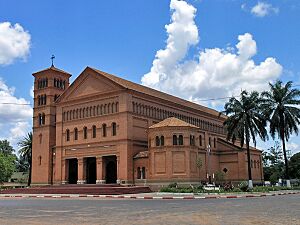
Christianity is the main religion in the DRC, with most people being Catholic or Protestant. A unique Christian movement called Kimbanguism also has many followers.
Islam has been present in the DRC since the 18th century. Traditional African religions are also practiced, often mixed with Christian beliefs. Some new churches have been criticized for promoting harmful beliefs, especially about witchcraft, which can lead to children being accused and mistreated. Charities like the Congo Children Trust help these children.
Education
In 2014, about 75.9% of people aged 15 to 49 could read and write. Primary education is supposed to be free, but it often is not. After the civil wars, many children did not go to school. However, the situation has improved a lot. The number of children in primary schools increased from 5.5 million in 2002 to 16.8 million in 2018.
Health
The DRC faces health challenges. It has one of the highest rates of infant mortality in the world. Diseases like malaria and yellow fever are common. There have also been outbreaks of Ebola. In 2020, millions of people faced hunger due to conflict and the COVID-19 pandemic. Air pollution is also a concern, affecting people's health.
Culture and Arts
The culture of the Democratic Republic of the Congo is very diverse, reflecting its many ethnic groups. Traditional ways of life have changed over time due to colonialism and conflicts, but many customs remain strong. Most people live in rural areas, but those in cities are more influenced by Western culture.
Music
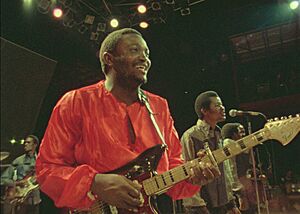
The Congo has a rich musical history. Early popular dance music was called Maringa. In the 1940s and 1950s, this style changed into "Congolese rumba" with influences from Cuban music. Artists like Franco Luambo and Antoine Wendo Kolosoy helped make this style famous.
Later, in the 1960s and 1970s, new styles like soukous emerged. Congolese musicians became known worldwide for their unique guitar playing. Many musicians moved to other countries, spreading Congolese music globally.
Sports
Many sports are popular in the DRC, including football (soccer), basketball, and rugby. The country is known for its professional basketball players in the NBA, like Dikembe Mutombo. Many Congolese football players have also become famous worldwide, such as Romelu Lukaku. The DR Congo national football team has won the Africa Cup of Nations twice.
Images for kids
See also
 In Spanish: República Democrática del Congo para niños
In Spanish: República Democrática del Congo para niños




